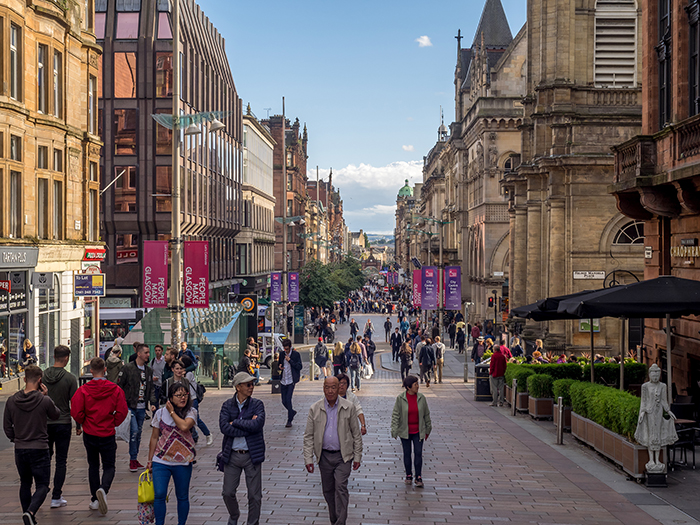
A consultation is set to go live on plans to pull together a series of actions to shape the regeneration of Glasgow city centre.
The plan includes the redevelopment of George Square, support for the night-time economy, and the creation of a new cultural quarter in the Sauchiehall Street area, as well as recommendations from the recent report on the city’s Golden Z (Argyle, Buchanan, and Sauchiehall Streets).
Following on from the first strategy, which covered the period between 2014 and 2019 and the work in recent years to aid the city’s Covid recovery, the latest proposals will take the city up to 2030 and come at a time of ‘significant’ change for urban centres.
Glasgow City Council explained that the rise of online shopping, the impact of the pandemic on office space and footfall, planning for net zero and new opportunities flowing from the emergence of new sectors locating in the city centre are addressed in the strategy.
Currently home to more than 150,000 jobs, over 4,000 businesses, and generating annual economic activity of almost £10 billion, Glasgow city centre remains Scotland’s most important economic asset, the local authority added.
The draft strategy will seek the approval of the city administration committee this week where, if successful, it will go out to public consultation.
Councillor Angus Millar, convener for city centre recovery at Glasgow City Council, said, “The city centre is experiencing significant and rapid change and that requires a clear and coherent vision to take that forward, one that ensures it remains Scotland’s most important economic space while becoming greener, more vibrant and with a much bigger population.”
Actions supporting the new strategy include the continuing roll out of the avenues programme, which has so far transformed large sections of Sauchiehall Street and is now extending into surrounding streets.
The Sauchiehall Street area would also be reimagined as Glasgow’s cultural quarter, while a new focus the evening and night-time economies would assist in the sector’s adaption to the changes in consumer habits affecting it. Other actions include small-scale greening including creating pocket parks, completing the development of Custom House Quay, and delivery of the River Park at the Broomielaw.
Former office space would be converted into residential and commercial uses, as well as seeking the necessary additional powers to enable more direct action to directly target owners of vacant/problem sites and delivering recommendations from the Golden Z research.
The strategy builds on proposals to support new residential communities with infrastructure and amenity space, such as play areas, improving connectivity with neighbourhoods such as Sighthill and Gorbals on the city centre periphery, and supporting community projects such as murals and winter lighting.
Furthermore, it would also ensure that the city is able to open more doors to digital, hi-tech, research and engineering businesses and start-ups seeking city centre locations, such as the plans for the Met Tower, which will open as a major new hi-tech centre next year.
Councillor Millar added, “The new city centre strategy brings together work from our vision for the ‘Golden Z’ of traditional shopping streets, to the regeneration of neighbourhoods like Garnethill, Broomielaw, Merchant City, and Townhead, through to the redevelopment of George Square and creation of a new cultural quarter.
“People across the city and beyond have a stake in the future of Glasgow city centre. It’s the heart of Scotland’s only metropolitan region and vital to the social and economic well-being of this city. I look forward to the coming public consultation on the strategy so that everyone can have their say.”
Last month, Project Scotland spoke to the leader of Glasgow City Council, councillor Susan Aitken, on plans for the future of Glasgow city centre – including learning lessons from Manchester and the potential build of skyscrapers. To read the article click here.








